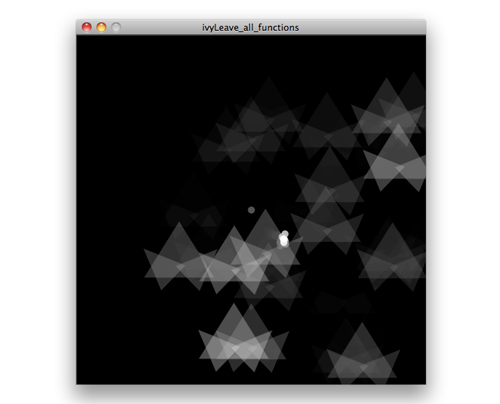Groving Ivy
Observations
short description
The pattern of growing ivy is a pretty dense one. The leaves are the smallest elements within that pattern. Looking at the boundaries of it you can observe that ivy grows up in lines, each covered with leaves to the left and right side by turn. Through this the pattern has an appearance like an organic, random grid which is extendable in all directions.
longer description
The pattern consists of one basic shape – the shape of the leaves. One leave has an organic figure which could be transformed into a geometric form. This geometric shape exists of three equilateral triangles: the first one is the biggest with the hypotenuse at the bottom. The other two triangles are smaller than the first one. They are half sized and arranged in a diagonal way. Two-thirds of those triangles are inside the bigger triangle. Their top shows one to the left and one to the right side. The leaves have different sizes which are organized randomly. They are arranged along a line, one to the left and one to the right side by turn. Those lines grow in parallel and even sometimes overlapping. Through this the pattern has an appearance like an organic, random grid which is extendable in all directions.
structure of the song
- soft, high, fading single tones ->from beginning till 4th seconds
- louder, deeper, fading single tones -> from 4th second till 16th seconds
- lasting note with higher sequence -> from 16th second
- another lasting note with deeper sequence -> from 19th second
- changing with higher sequence note by turn every 3rd second -> till 59th second
- deep lasting note - instead of changing tones -> from 59th second till 81st second
- very deep lasting note -> lasting for 3 seconds with a delay of another 3 seconds, as a loop
- two high notes: first = clear and second = bit higher + fading; changing by turn-> from 81st second
- unregularly short cut and deep tones -> from 81st second
- singing voice of a woman, fading -> from 103rd second
- singing voice of a woman, clear and louder -> from 124th second
- kind of irregular beat -> from 124th second
in Processing
For Processing I wanted to create a programing code that simulates the natural way how ivy grows. The blinking ball at the beginning of the code reacts according to the music and embodies the origin of the growing plant. When the ball starts to move over the screen with the blurry effect, it stands for the randomly growing boughs, the main structure for the ivy leaves. The leaves itself are drawn when the music gets louder and rougher in its sound. They are drawn with random distances, like they would grow naturally.
PROGRAM
sketches
ivy leave
void setup() {
size(500, 500);
background(255);
smooth();
stroke(55);
strokeWeight(0.25);
frameRate(15);
}
void draw() {
background(0);
for (int i = 0; i < 5; i++) {
pushMatrix();
for (int j = 0; j < 5; j++) {
float colorFactor = calculateColorFactor(random(1.5, 3.5));
ivyLeave(colorFactor);
translate(80, 0);
}
popMatrix();
translate(0, 80);
}
float timeInSeconds = millis()/1000;
if (timeInSeconds % 5 == 0) {
println("five seconds have passed");
}
}
void ivyLeave(float colorFactor) {
fill(colorFactor*10, 50);
noStroke();
triangle(50, 120, 100, 40, 150, 120);
pushMatrix();
rotate(150);
translate(-62, 20);
triangle(15, 130, 40, 70, 65, 130);
popMatrix();
pushMatrix();
rotate(-150);
translate(125, -125);
triangle(15, 130, 40, 70, 65, 130);
popMatrix();
}
float calculateColorFactor(float r) {
float newColor = r*10;
return newColor;
}ivy leave 2
void setup() {
size(500, 500);
background(0);
smooth();
stroke(55);
strokeWeight(0.25);
frameRate(15);
}
void draw() {
//background(0);
//fill(0,50);
//rect(0,0,width,height);
if (mousePressed == true) {
variableIvyLeave();
}
}
void ivyLeave() {
//noStroke();
fill(150, 50);
pushMatrix();
translate(-50, -120);
triangle(50, 120, 100, 40, 150, 120);
pushMatrix();
rotate(150);
translate(-62, 20);
triangle(15, 130, 40, 70, 65, 130);
popMatrix();
pushMatrix();
rotate(-150);
translate(125, -125);
triangle(15, 130, 40, 70, 65, 130);
popMatrix();
popMatrix();
}
void variableIvyLeave() {
pushMatrix();
translate(mouseX, mouseY);
ivyLeave();
popMatrix();
}ivy leave 3
float x = 0;
float y = 0;
float speedX;
float speedY;
float velocityX = 1.0;
float velocityY = 1.0;
//--------------------------
void setup(){
size(500,500);
background(0);
smooth();
frameRate(15);
}
void draw(){
background(0);
speedX = random(-3, 5);
speedY = random(-5, 5);
variableIvyLeave(x,y);
float timeInSeconds = millis()/1000;
if (timeInSeconds % 1 == 0) {
variableIvyLeave(x,y);
}
if ((x > width) || (x < 0)) {
speedX = abs(speedX);
velocityX = -velocityX;
}
if ((y > height) || (y < 0)) {
speedY = abs(speedY);
velocityY = -velocityY;
}
x += speedX * velocityX;
y += speedY * velocityY;
}
//---------------------------------------
void ivyLeave(){
stroke(55);
strokeWeight(0.25); fill(250,60);
//triangle large
triangle(50,120, 100,40, 150,120);
//triangle small left
pushMatrix();
rotate(150);
translate(-62,20);
triangle(15,130, 40,70, 65,130);
popMatrix();
//triangle small right
pushMatrix();
rotate(-150);
translate(125,-125);
triangle(15,130, 40,70, 65,130);
popMatrix();
}
void variableIvyLeave(float x, float y){
pushMatrix();
translate(x,y);
x += random(1,9);
y += random(1,11);
ivyLeave();
popMatrix();
}ivy leave 4
File:Processing einfuehrung julia ivy4.zip
final version
File:Processing einfuehrung julia all.zip




